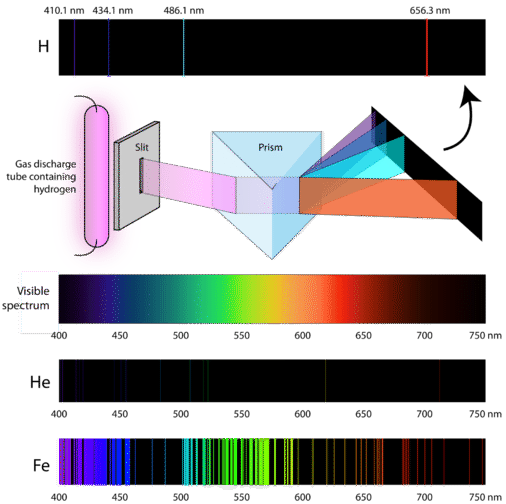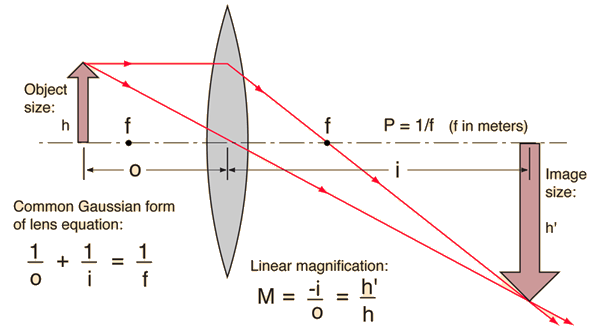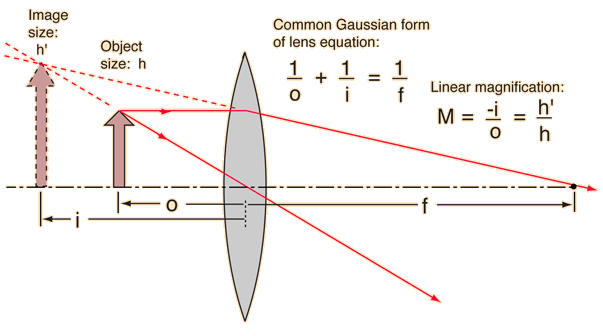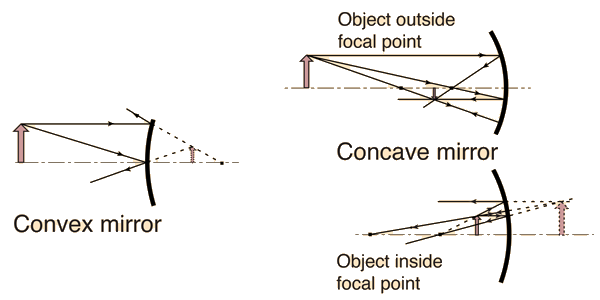EM Waves, Light & Telescopes
Electromagnetic Waves
Oscillating charges create oscillating magnetic fields, which in turn create oscillating electric fields



The result are oscillating electric and magnetic fields that regenerate each other while traveling on space
Electromagnetic Waves
E&M waves need not material medium to travel, the can travel in vacuum

E&M waves have the standard properties of waves
Speed of light = 3x10^8 m/s

Waves
The time required for a full length to pass a given point (one full cycle)
Period:
Frequency:
Number of oscillations per unit time
1 Hertz = 1 oscillation per second
For example, for a period of 2 seconds per oscillation, the frequency is ½ oscillations per second or ½ Hertz
The speed at which waves travel through a medium is related to the frequency and wavelength
Wave Speed

Waves
Vibrations are the source of all waves

For example electrons in the antenna of an AM radio station at 960 kHz vibrate 960,000 times each second, producing 960 kHz radio waves
Electromagnetic Waves
E&M waves need not material medium to travel

E&M waves have the standard properties of waves
Speed of light is 3x10^8 m/s

Electromagnetic Spectrum

Wavelength (m)
Light :

E&M waves in the visible range of the spectrum


Normal: Line perpendicular to interface
Checkpoint 1
What color of light has the highest frequency?
Checkpoint 2
What color of light has the shortest wavelength?
Violet
Violet
Refraction and Dispersion of Light
Wave Refraction
The bending of waves due to change of speed


Refraction of Light
Light rays refract (bend) when they pass from one medium to another at an oblique (not straigth) angle
Refraction is the result of waves changing speed as they cross from one medium to anoter

Direction of Refraction

Waves bend towards the normal when going from fast to slow
and
away from the normal when going from slow to fast
Checkpoint 3
If you want to spear a fish from above the water, do you have to aim higher or lower?



Image
Actual
Lower

Dispersion happens because the refraction of light is frequency dependent
This is because higher frequency light travels slower inside the prism
Slowest
Fastest
Dispersion of Light
Vision and Color

The radiation curve of sunlight is a graph of brightness versus frequency. Sunlight is brightest in the yellow-green region.
Sunlight
The ultraviolet catastrophe was solved by Max Planck. Assuming that EM radiation was emitted in discrete packets (quanta) Plank was able to explain black-body radiation
Light Quanta
Plank's found the emission of radiation is quantized, meaning that radiation energy can only be transferred in chunks of size:
The Photon (Light Particles)
In 1905 Einstein introduced the concept of the photon to explain the photoelectric effect


Text
Light is emitted and absorbed in packets called photons. The photon energy is proportional to the frequency of light and given by E = hf
Text
So, is light made out of particles or waves?
The Wave-Particle Duality
In quantum physics (the physics of sub-atomic scales) not just light but matter and energy must be explained as both, particles and waves
In Einstein's Words:
It seems as though we must use sometimes the one theory and sometimes the other, while at times we may use either. We are faced with a new kind of difficulty. We have two contradictory pictures of reality; separately neither of them fully explains the phenomena of light, but together they do.
Light Emission

Charged particle or Photon
Atoms emit light when their electrons change from higher energy levels to lower energy levels
A photon is emitted when an electron gets de-excited
Atomic Energy Levels

Explanation of Quantized Energy Levels
Electrons can only be at discrete energy levels (orbit radius), because the circumference of their orbit has to be an integer number of their wavelength in order to form standing waves, otherwise the experience destructive interference

In 1924 Louis de Broglie's suggested that electrons have a wavelength. This explained the quantized energy levels of atoms


Atomic Energy Levels
Electrons can only be at discrete energy levels (orbit radius), so that the circumference of their orbit is an integer number of their wavelength


1
2
3
4
5
1
1
1
1

Atomic Energy Levels
Different atoms have different radius (potential energy) and thus different energy levels for their electrons

Emission Spectrum
If you disperse the light emitted by specific elements, you would get a characteristic spectrum for each element
Each element has different emission spectrum, which can be thought as the signature of that element
Checkpoint 4
On the emission spectrum of Hydrogen there is visible line at 660 nm, what is the energy of the photons producing this line ?

660 nm
Emission Spectrum
Each element has different emission spectrum, which can be thought as the signature of that element

Mostly hydrogen (Pinkish Color)

Planetary nebula are metal rich (Many Colors)


Hourglass Nebula
Ring Nebula
Absorption Spectrum

If electrons in an atom get excited by light, they absorb photons at the same specific frequencies as they would emit when de-excited

Reflection of Light
Law of Reflection
The angle of incidence equals the angle of reflection

This Is the result of Fermat's principle of least time

Diffuse vs. Specular Reflection

Diffuse
Specular
Incoming light scattered in all directions
Incoming light reflected in one direction
Law of reflection holds in both cases, diffuse reflection is the result of rough surfaces
Mirrors
Mirrors are the result of specular reflection

Tracing light rays from original, to mirror, to eye allows us to construct the image

Checkpoint 1
Which person in the front row sees the guy with the hat (person F) in the mirror?

Non-Flat Mirrors
Image in a curved mirror is distorted from original


Convex Mirrors

Image from convex mirror is smaller and closer than original
Convex Mirrors
Image from convex mirror is smaller than original

Concave Mirrors

Image from concave mirror is larger and farther than original if object close to mirror
Concave Mirrors
We use concave mirrors to build telescopes in order to collect light and focus it to the detector or eyepiece


Lenses
Wave Refraction
The bending of waves due to change of speed


Refraction of Light
Light rays refract (bend) when they pass from one medium to another at an oblique (not straigth) angle
Refraction is the result of waves changing speed as they cross from one medium to anoter


Dispersion happens because the refraction of light is frequency dependent
This is because higher frequencies travel slower inside the prism
Slowest
Fastest
Dispersion of Light
Lenses


Curved surface of a convex lens causes light rays to converge, magnifying images
Convex Lenses

Curved surface of a concave lens causes light rays to diverge, shrinking images

Concave Lenses

Lenses
Telescopes
Telescopes are Light Buckets
The main purpose of telescopes is to collect as much light as possible while maintaining as much detail as possible


Both the light gathering power and resolution of a telescope increases with the diameter/area of the telescope
Refractors vs. Reflectors
There are two ways to collect light in a telescope. By refraction or by reflection


Refracting telescopes use a primary/objective lens to collect light by refraction
Reflecting telescopes use a primary/objective mirror to collect light by reflection
Refracting Telescopes

Refracting telescopes have many disadvantages:
- The become too long for not that much light collecting area
- Large lenses are extremely expensive to fabricate
- A large lens will sag in the center since it can only be supported on the edges
- Dispersion causes images to have colored fringes

Refracting Telescopes Suffer from Chromatic Aberration


Slowest
Fastest
Refracting Telescopes Suffer from Chromatic Aberration


Reflecting Telescopes

Reflecting telescopes use a parabolic primary mirror to collect light. Light is focused in front of the mirror, how you observed it without blocking the incoming light?
Reflecting Telescopes

Reflecting telescopes use either detectors or secondary mirrors to gather or re-direct the focused light from the primary mirror
Reflecting Telescopes
Professional telescopes use a detector placed at the focal point of the primary mirror


Telescope Magnification



Text
Checkpoint 2
The telescopes we used in class have a focal length of 1200 mm. What is the magnification when using a 25 mm eyepiece?
M = 1200 mm/ 25 mm = 48

Telescope Resolution

A telescope’s ability to discern detail is referred to as its resolution or resolving power
The better the resolution the smaller angular separations a telescope can dicern
Telescopes and Diffraction
Diffraction is the bending of waves around corners and gap openings
- The smaller the opening the larger the diffraction
The resolving power of a telescope is limited by the wave nature of light through a phenomenon called diffraction
- Long wavelengths diffract more than short wavelengths, e.g. red light diffracts more than blue light


Resolving power is proportional the to the telescope diameter and inversely proportional to wavelength
Checkpoint 2
What would improve the resolution of a telescope?
Increasing the diameter of the telescope and Observing shorter wavelengths of light/radiation

Space and Non-optical Telescopes


Space and Non-optical Telescopes
Only visible and short wavelength radio waves (10 cm - 10 m) reach the ground
Radio Telescopes






Long-Scale Interferometry
The Event Horizon Telescope
The image of a black hole, imaged by the Event Horizon Telescope and published in April 2019.


The Milky Way Observed at Different Wavelenghts
Telescope Instruments
Cameras and Charged Coupled Devices (CCDs)




Spectrographs
The End

Waves
Vibrations create waves. A sine curve is a pictorial representation of a wave

The Bohr model of the atom is explained by de Broglie's equation


Virtual vs. Real Images in Lenses
Real Image
Virtual Image
Virtual vs. Real Images in Mirrors

Real Image
Virtual Image